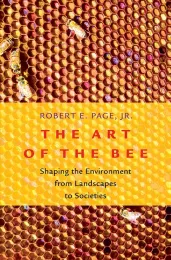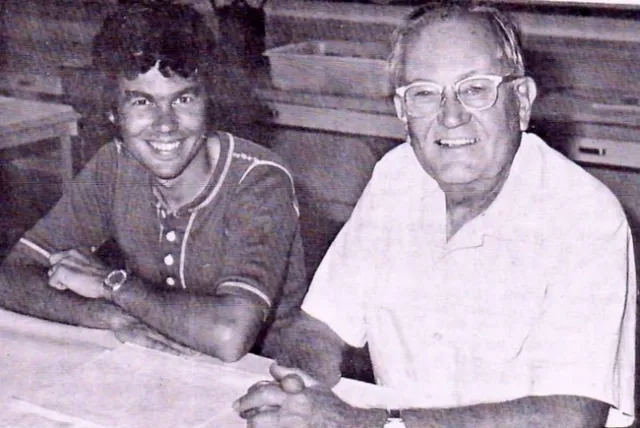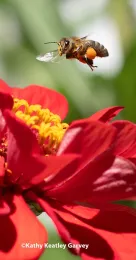
Newly retired from teaching but not entirely from research, Page holds the titles of ASU Provost Emeritus and Regents Professor Emeritus, as well as UC Davis Entomology Chair Emeritus.
Bee World published his article, "The Art of the Bee," as well as a one-on-one interview with editor Robert Brodschneider in a piece titled "Robert E. Page Jr--Mapper of the Genetic Architecture of the Honey Bee."
In his article, Page zeroes in on his latest book, The Art of the Bee: Shaping the Environment from Landscapes to Societies, 2020, Oxford University Press), focusing on the importance of honey bees and making science understandable to the public.
Page applauds the work of Alexander von Humboldt (1769-1859), known as a German geographer, naturalist, explorer, and proponent of Romantic philosophy and science.
"Von Humboldt appealed to artists to learn about nature, and ecology, and paint it," Page wrote. "He believed that artists and writers could do more to advance an understanding of science and nature than the scientific specialist. His plea was for making science understandable to the public, a plea for popular science."
Page strongly supports that plea. Earlier this year, he created a free and publicly accessible YouTube channel, "The Art of the Bee," at https://www.youtube.com/@artofthebee to do just that.
His YouTube channel guides the viewer through "the fascinating biology and behavior of the bee," presented in 38 videos from 4 to 27 minutes in length. He organized the videos into six series that roughly correspond to the nine chapters of the book. He included "a rich set of illustrations, images, and videos, to paint a narrative in the spirit of von Humboldt."

In the first segment, Page writes: "One hundred twenty-five million years ago, the earth exploded with colour with the rapid evolution of flowering plants. The explosion coincided with a rapid increase of species of bees. The bees and flowering plants were locked in a dialectical dance of coevolution, each becoming adapted to the other. The flowers evolved to exploit the feeding habits of bees, and bees evolved to rob the flowers of their precious loads of pollen and nectar. Bees became social and developed communication and navigational systems to better exploit their environment. They continue to transform our world through their effects on the agricultural landscapes and the food we eat. Honey bees have evolved mechanisms to forage optimally both as individuals and colonies, expending their energy and short lives to maximally provision their nest. Their communication system directs foragers to different floral patches at different times of day reflected in the changing kaleidoscope of colour on the legs of returning pollen foragers. Their pollination transforms the landscape in the spring into splashes of colour resembling a painter's pallet."
Page's Bee World article includes this text from his book: "The impact of bees on our world is immeasurable. Bees are responsible for the evolution of the vast array of brightly-colored flowers and for engineering the niches of multitudes of plants, animals, and microbes. They've painted our landscapes with flowers through their pollination activities and have evolved the most complex societies to aid their exploitation of the environment. The biology of the honey bee is one that reflects their role in transforming environments with their anatomical adaptations and a complex language that together function to exploit floral resources. A complex social system that includes a division of labour builds, defends, and provisions nests containing tens of thousands of individuals, only one of whom reproduces. Traditional biology texts present stratified layers of knowledge where the reader excavates levels of biological organization, each building on the last. This book (The Art of the Bee: Shaping the Environment from Landscapes to Societies) presents fundamental biology, not in layers, but wrapped around interesting themes and concepts, and in ways designed to explore and understand each concept. It examines the coevolution of bees and flowering plants, bees as engineers of the environment, the evolution of sociality, the honey bee as a superorganism and how it evolves, and the mating behaviour of the queen."

Native of Bakersfield. A native of Bakersfield, Rob holds a bachelor's degree in entomology (1976), with a minor in chemistry, from San Jose State University. He obtained his doctorate in entomology (1980) from UC Davis; joined the UC Davis faculty in 1989; and chaired the Department of Entomology from 1999 to 2004.
After retiring from UC Davis in 2004, he accepted an appointment at Arizona State University as founding director of the School of Life Sciences. He served as provost of Arizona State University (2013- 2015) and dean of the College of Liberal Arts and Sciences (2011-2013). His research on honey bee behavior and genetics appears in his publications Queen Rearing and Bee Breeding (1997, with Harry H. Laidlaw Jr., his doctoral research mentor at UC Davis and "the father of honey bee genetics"); The Spirit of the Hive, Harvard University Press (2013); and The Art of the Bee, Oxford University Press (2020). His 230-plus research papers have been cited more than 20,000 times.
Much of his research occurred at UC Davis. For 24 years, from 1989 to 2015, Page maintained a honey bee-breeding program, managed by bee breeder-geneticist Kim Fondrk. Their contributions include discovering a link between social behavior and maternal traits in bees. Their work was featured in a cover story in the journal Nature. In all, Nature featured his work on four covers from work mostly done at UC Davis.
Bee World Interview. In the interview with Bee World editor Brodschneider of the Institute of Biology, University of Graz, Austria, Page told him: "I have never been a hobby beekeeper. I have only kept bees for my experimental needs. I have kept more than 300 hives at a time, but I had an excellent technician for about 25 years, Kim Fondrk. Kim could do everything: instrumental insemination, raise queens, manage large numbers of colonies, run gel electrophoresis and PCR in the lab, and even constructed some of the equipment we used in the lab. I was very fortunate because I wasn't a very good beekeeper. I would only pay attention to one thing at a time. I didn't have the eye for seeing apicultural problems."

Brodschneider: "What would you rate as your most important research finding in honey bees?"
Page: "I think that must be mapping the phenotypic and genetic architectures of pollen hoarding behavior. It wasn't a fast 'discovery' but the result of 30 years of being fixated on the question 'how do bees evolve complex social behavior.' I used pollen hoarding (the storing of surplus pollen in the nest) as my study phenotype and looked at all levels of biological organization from gene to complex social interactions to construct the architectures."
Brodschneider: "How about your honey bee breeding experiments?"
Page: "I had three over my career. The first was done with Norman Gary (now emeritus professor, UC Davis Department of Entomology and Nematology). We did a bi-directional selection for resistance to tracheal mites. We did this soon after they were introduced into North America and were causing a lot of problems for beekeepers. We successfully selected a line that was resistant to tracheal mites and another that was very susceptible. We demonstrated that it was possible to select for resistance. The bi-directional selection for pollen hoarding went on for 25 years and was very successful. The high strain stored more than 10 times the amount of pollen in the combs than did the low strain. These strains became our tools to dissect the genetic and phenotypic architectures. Gloria Hoffman at the Tucson USDA research lab, Kim Fondrk, and I did a very careful bi-directional selection study on varroa resistance. We were not successful. We were selecting for physiological resistance of larvae to varroa. This was our only failure. I don't think it is really possible to succeed. I don't think there is sufficient genetic variation. Certainly no one has done it more carefully or more controlled than we did."
Brodschneider: "Which big research questions in bees remain unsolved?"
Page: "They are all big. I think understanding the genetic networks that control behavior, development, and resistance to bee diseases will dominate honey bee research for the next generation. But, there is still so much to learn about basic methods of culturing bees such as: in vitro rearing of queens, drones, and workers; maintaining viable colonies of bees in confinement; sperm and embryo storage, nutritional substitutes; controlling the foraging of colonies, etc."
Brodschneider: "Are you still involved in some research?"
Page: "What I think is my final research paper is submitted for publication. I am one of several authors but I am very proud of my contribution. It is a paper about how you can take a large set of gene expression data and derive from it coordinated sets of genes that represent a network of interactions controlling a behavior or a physiological function."
Brodschneider: "Together with Harry Laidlaw you worked on bee breeding in the early 1980s. What has changed since then in the honey bee stock kept in the United States and in the breeding programs?"
Page: "I don't think much has changed at all with respect to commercial breeding programs. Queen producers are still primarily queen producers and not queen breeders. I think they do control their stock somewhat through their culling process when they select queen and drone mother colonies. The very few that do really breed bees, like Sue Cobey (who studied with Laidlaw and later became a bee breeder-geneticist at UC Davis and is now with Washington State University) and her New World Carniolans use traditional breeding methods: measure phenotypes, select parents, control matings, and get stock improvements. Sue is one of the few to use instrumental insemination to control mating. I suspect practices today are much like what has gone on since the beginning of agriculture in human societies. I think there is only so far you can go with these methods because there are constraints on what phenotypes you can 'squeeze' out of the honey bee genome. And there are serious social constraints, for example, if you breed too far for hygienic behavior you can get colonies that tear down all of the comb and don't raise brood. Or if you do like I did, breed colonies to collect too much pollen it is pathological because they plug up the brood nest with pollen. We have not yet seen modern molecular genetic tools provide stock improvement, though there has been some limited use of them for markers used in selection. There are severe obstacles due primarily to its social system. For example, if you genetically modify a queen or workers, larvae or adults, they will be detected by the other workers and eliminated. Changing social structure is complex."
Page described current beekeeping in the United States as "Adaptable and curious. It is amazing how quickly and how well the industry responds to the plethora of problems, old and new, that confront the industry. And they succeed because every commercial beekeeper I ever met was curious and was always experimenting to find better ways."
In other comments, Page said that the most urgent problems in beekeeping today involve "Varroa, varroa, varroa. We have to keep looking for better control and management methods. I have been surprised that researchers and the bee industry have done as well as they have to stay ahead of the potential total disaster that varroa can cause."
Resources:
- "Why Bees Are Artists and Engineers: Robert E. Page's New Book," July 30, 2020, Bug Squad blog, UC Agriculture and Natural Resources
- Rob Page's Newly Launched YouTube Channel: The Fascinating World of Bees," May 4, 2023, UC Davis Department of Entomology and Nematology
- Honey Bee Geneticist Rob Page Named UC Davis Distinguished Professor, Jan. 8, 2018, UC Davis Department of Entomology and Nematology

